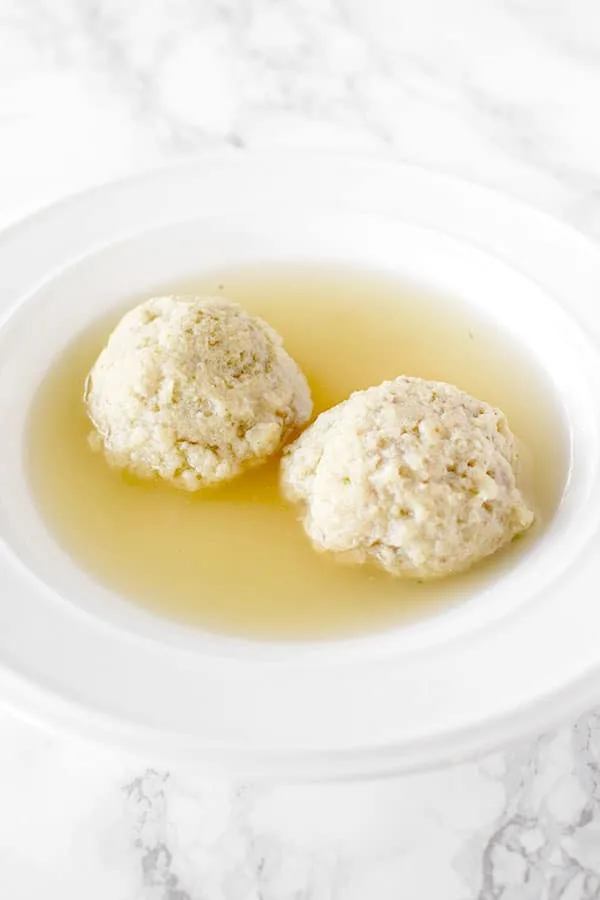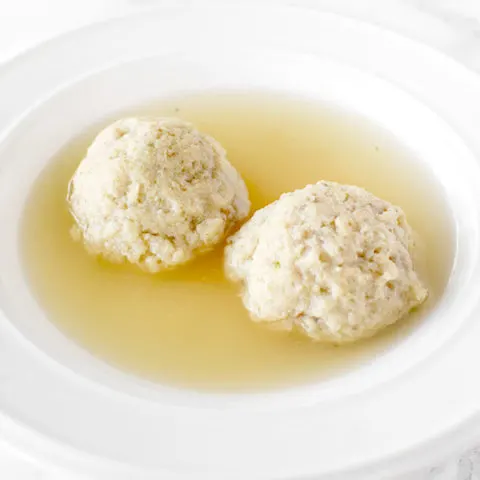These perfect matzo balls are simple to make and come out light and fluffy. They are everything one dreams of from "floater matzo balls" and more.

I don’t think there is any more iconic Jewish or Passover (Pesach) food than matzo ball soup.
My whole family waits all year for it and have started making it on occasion when it isn’t Pesach.
When my brother was spending his gap year in Israel, the hardest part for him was missing the matzo ball soup.
He even made my Mom promise she’d make it when he got back in the summer, and she did.
This was many years ago, but to this day it is still his favorite food.
In fact, since moving to Israel, our Mom now promises to make it for him when he comes to visit from the States where he chose to stay.
Since the rest of the family moved to Israel, my mom decided to start making matzo ball soup herself because she didn’t like the prices on the packages.
We tried a number of popular recipes but none compared to the box stuff we used in the States.
This caused every Pesach meal to start out disappointing with grumbles and comments from my younger brothers.
So, after a while, I became determined to create the perfect recipe.
I looked at the recipes we had tried and gotten disappointing results from to see where I could improve.
I decided to keep everything the same except the leavener.
Trail and Error
First, I raised the baking powder to one teaspoon. It wasn’t much better than before.
Next, I tried ½ a teaspoon of baking soda. I did this because while every recipe I saw used baking powder, baking soda was listed in the ingredients on the box.
This gave me matzo balls that were fluffy on the outside and firm on the inside.
I liked them, but my goal was to get the fluffy box stuff so I kept on.
Finally, I tried 2 teaspoons of baking powder. These came out perfect!
However… they were a little boring since they didn’t have any seasoning.
So, looking at the box again, I saw that it included onion powder and garlic powder.
This made all the difference.
CAN YOU USE BAKING POWDER ON PASSOVER?
Absolutely! As long as the box is marked kosher for Passover with a “P” next to the kosher symbol.
I get this question a lot because of the fact that it is a leavener.
The truth is though, while laws regarding Passover are complex, the focus is on wheat flour rather than the leavener itself.
In fact, there wasn’t anything to leaven bread in ancient times except wild yeast.
So, the bread they were making was something of a sour dough bread.
This is the reason it took so long to rise.
BAKING SODA VS BAKING POWDER
Both baking soda and baking powder are leavening agents, which means that they help baked goods rise. However, they're not the same thing and they are not interchangeable.
Using baking soda instead of baking powder can give your recipe a terrible metallic taste, while using baking powder instead of baking soda leaves your baked goods looking flat.
BAKING SODA
When baking soda (also known as sodium bicarbonate) is combined with acidic ingredients and exposed to heat, it causes batter or dough rise and contributes to their light and fluffy texture.
However, baking soda is a versatile ingredient. It can be sprinkled over meat to tenderize it and it can be added to tomato sauce to neutralize the acidity.
Baking soda, when combined with an acid - such as cream of tartar, lemon juice, buttermilk, cocoa, and vinegar - creates carbon dioxide. When the carbon dioxide is released, it causes the familiar texture and crumb in pancakes, cakes, quick breads, soda bread, and other baked and fried foods.
A good rule of thumb is to use around ¼ teaspoon of baking soda per 1 cup of flour.
BAKING POWDER
Baking powder is created by combining baking soda, cream of tartar, and sometimes cornstarch.
Since baking powder already contains an acid, it's most often used when a recipe does not call for an additional acidic ingredient or calls for too little of one.
There are two types of baking powder. Single-acting baking powder and double-acting baking power.
Single-acting baking powder gets activated only once - when it gets wet.
Most baking powder sold is double-acting. This means that the leavening occurs in two steps.
The first is when the baking powder gets wet, which is why you cannot prepare some batters ahead of time to bake later. The second step is when the baking powder is exposed to heat, which happens when the batter is baked or fried.
A good rule of thumb is to use around 1 teaspoon of baking powder per 1 cup of flour.
WHY SOME RECIPES CALL FOR BOTH
Some recipes use both baking soda and baking powder because they need extra leavening that the baking soda alone cannot provide.
In these cases, baking soda provides an initial lift, while baking powder provides additional rise.
WHICH ONE IS STRONGER?
You may have already guessed the answer since baking soda is used to make baking powder and you need more baking powder per cup of flour. But I’ll tell you anyway.
Baking soda is four times stronger than baking powder.
That's why you will, more often than not, see recipes that only call for baking soda rather than recipes that only call for baking powder.
HOW LONG DO THEY LAST?
BAKING SODA
Baking soda is good indefinitely past its best by date, although it can lose potency over time.
A good rule of thumb is two years for an unopened package and six months for an opened package.
However, to be honest, I’ve used very old baking soda with good results.
BAKING POWDER
Like baking soda, baking powder is good indefinitely past its best by date, and can lose its potency over time.
For both opened and unopened, it’s ideal to use it within nine months to a year.
While storing it, make sure to keep it in a dry place and away from humidity.
HOW TO TEST IF IT’S STILL GOOD
BAKING POWDER
To test baking powder, pour 3 tablespoons of warm water into a small bowl, add ½ teaspoon of baking powder, and stir.
If the baking powder is good to use, it should fizz a little.
BAKING SODA
To test baking soda, pour 3 tablespoons of white distilled vinegar into a small bowl, add ½ teaspoon of baking soda, and stir.
The mixture should rapidly bubble if the soda is fresh.
What is the difference between matzo balls and dumplings?
Matzo balls are a specific type of dumpling in that they are made using matzo meal.
The box doesn't have liquid in the recipe. Why does yours?
I tried making it without the liquid, but it came out way too dry.
I think it's because the box matzo mix meal is very fine whereas regular matzo meal is coarse.
My guess is, the fine matzo meal doesn't need as much liquid.
Schmaltz vs Oil
Schmaltz is the traditional fat used in matzo balls. However, in recent decades, oil has become at least as common.
While I usually use oil for convenience, many say that schmaltz elevates the flavor of the matzo ball.
Chilling
You can chill the matzo balls for anywhere between 15 minutes and overnight.
However, this will make your matzo balls firmer than they would be if you didn't chill them.
I don't chill mine because I like them fluffy on the outside and to have some substance on the inside but not firm.
Make Ahead
Matzo balls can be made ahead of time.
Just cook them, remove them from the liquid, and refrigerate them in a resealable plastic bag or airtight container.
Refrigerate for 3 to 5 days.
Freeze
You can freeze matzo balls on a tray and then move them to a resealable plastic bag or airtight container.
Freeze for up to 3 months.
After three months, they are still safe to eat, but their quality begins to degrade.
Perfect Matzo Balls

These matzo balls are perfectly light and fluffy, just like the stuff you get out of a box. Matzo balls really don't get better than this!
Ingredients
- 1 cup matzo meal (115 grams)
- 2 teaspoon baking powder
- ½ teaspoon salt
- ½ teaspoon garlic powder
- ½ teaspoon onion powder
- 4 large eggs
- ¼ cup oil or melted schmaltz (60 milliliters)
- ¼ cup water or stock (60 milliliters)
Instructions
- In a large mixing bowl, add matzo meal, baking powder, salt, garlic powder, and onion powder. Whisk to combine.
- Add eggs, water, and schmaltz or oil. Mix with a fork until combined.
- For firmer matzo balls, chill for 20 minutes or longer. For matzo balls that are fluffy on the outside but have substance on the inside, let them sit at room temperature.
- Fill a wide pot with water or stock and bring to a boil.
- With wet hands, take some of the mix and mold it into the size of a ping-pong ball. Gently drop it into the boiling water. Repeat until done.
- Reduce the heat to a simmer. Cook 20 minutes or until a toothpick goes smoothly through a little passed the center of the matzo balls. Do not stir the pot until the matzo balls are done cooking, or else they will fall apart.
Notes
If you don't want to chill the mix, you can let it sit out at room temperature. Letting the mix chill makes the mix less sticky.
Nutrition Information:
Yield:
15Serving Size:
1Amount Per Serving: Calories: 119Total Fat: 5gSaturated Fat: 1gTrans Fat: 0gUnsaturated Fat: 4gCholesterol: 50mgSodium: 178mgCarbohydrates: 14gFiber: 0gSugar: 0gProtein: 4g
Maya
Friday 19th of January 2024
Pro tip from a professional chef:
Use seltzer water instead of flat water!!! It makes a significant difference in the fluffy airiness of the balls!
ElissaBeth
Monday 22nd of January 2024
Good tip :)
Kim
Tuesday 14th of November 2023
Hi, Is it correct that only one matzo ball is a serving?
ElissaBeth
Monday 20th of November 2023
I always serve a bowl with two matzo balls but for calories and nutrition it's one matzo ball.
Friday 4th of August 2023
Made these came out great!
ElissaBeth
Monday 7th of August 2023
I'm glad to hear you enjoyed them :)
Lorena
Wednesday 11th of May 2022
Help please. Not sure if living at high altitude (over 7,000 ft) affected things, but the matzo balls instantly floated to the top, never sinking to signal they were done when rising to the surface. Some also disintegrated by the prescribed cooking time.
ElissaBeth
Tuesday 2nd of August 2022
You don't need to worry if they don't sink. Mine usually don't either. Just let them keep cooking until they're ready.
Jan
Monday 3rd of January 2022
Shalom, Going to make them rt now. I used toasted onion matzoh from Israel. Put in processor and then into the bowl. I am going to try the half teaspoon of baking soda because the texture you described sounded perfect to me. Thank you for the great recipe. I am excited to see final results. Todah:)
ElissaBeth
Monday 3rd of January 2022
I hope you enjoy them! :)